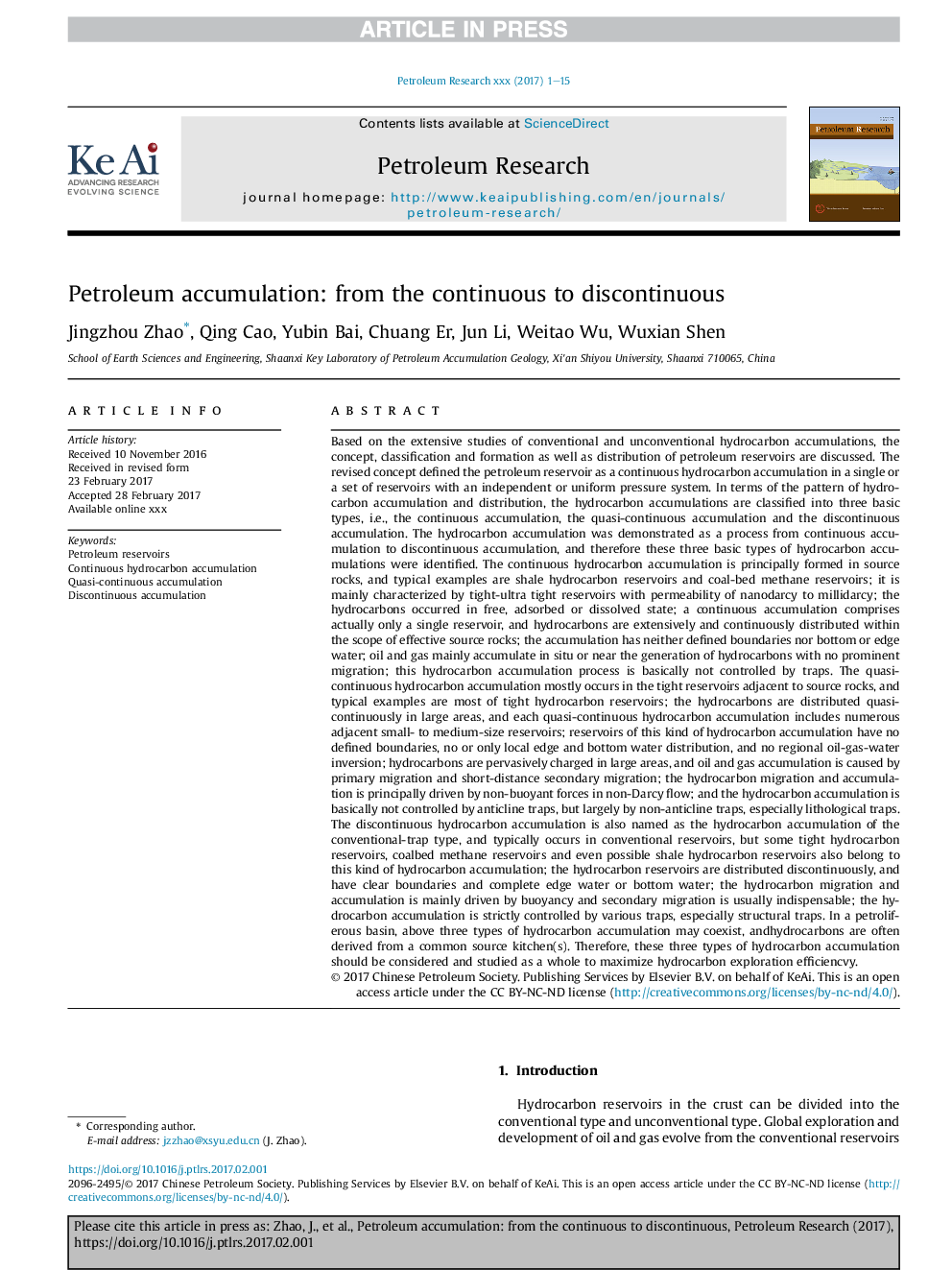| Article ID | Journal | Published Year | Pages | File Type |
|---|---|---|---|---|
| 8918329 | Petroleum Research | 2017 | 15 Pages |
Abstract
Based on the extensive studies of conventional and unconventional hydrocarbon accumulations, the concept, classification and formation as well as distribution of petroleum reservoirs are discussed. The revised concept defined the petroleum reservoir as a continuous hydrocarbon accumulation in a single or a set of reservoirs with an independent or uniform pressure system. In terms of the pattern of hydrocarbon accumulation and distribution, the hydrocarbon accumulations are classified into three basic types, i.e., the continuous accumulation, the quasi-continuous accumulation and the discontinuous accumulation. The hydrocarbon accumulation was demonstrated as a process from continuous accumulation to discontinuous accumulation, and therefore these three basic types of hydrocarbon accumulations were identified. The continuous hydrocarbon accumulation is principally formed in source rocks, and typical examples are shale hydrocarbon reservoirs and coal-bed methane reservoirs; it is mainly characterized by tight-ultra tight reservoirs with permeability of nanodarcy to millidarcy; the hydrocarbons occurred in free, adsorbed or dissolved state; a continuous accumulation comprises actually only a single reservoir, and hydrocarbons are extensively and continuously distributed within the scope of effective source rocks; the accumulation has neither defined boundaries nor bottom or edge water; oil and gas mainly accumulate in situ or near the generation of hydrocarbons with no prominent migration; this hydrocarbon accumulation process is basically not controlled by traps. The quasi-continuous hydrocarbon accumulation mostly occurs in the tight reservoirs adjacent to source rocks, and typical examples are most of tight hydrocarbon reservoirs; the hydrocarbons are distributed quasi-continuously in large areas, and each quasi-continuous hydrocarbon accumulation includes numerous adjacent small- to medium-size reservoirs; reservoirs of this kind of hydrocarbon accumulation have no defined boundaries, no or only local edge and bottom water distribution, and no regional oil-gas-water inversion; hydrocarbons are pervasively charged in large areas, and oil and gas accumulation is caused by primary migration and short-distance secondary migration; the hydrocarbon migration and accumulation is principally driven by non-buoyant forces in non-Darcy flow; and the hydrocarbon accumulation is basically not controlled by anticline traps, but largely by non-anticline traps, especially lithological traps. The discontinuous hydrocarbon accumulation is also named as the hydrocarbon accumulation of the conventional-trap type, and typically occurs in conventional reservoirs, but some tight hydrocarbon reservoirs, coalbed methane reservoirs and even possible shale hydrocarbon reservoirs also belong to this kind of hydrocarbon accumulation; the hydrocarbon reservoirs are distributed discontinuously, and have clear boundaries and complete edge water or bottom water; the hydrocarbon migration and accumulation is mainly driven by buoyancy and secondary migration is usually indispensable; the hydrocarbon accumulation is strictly controlled by various traps, especially structural traps. In a petroliferous basin, above three types of hydrocarbon accumulation may coexist, andhydrocarbons are often derived from a common source kitchen(s). Therefore, these three types of hydrocarbon accumulation should be considered and studied as a whole to maximize hydrocarbon exploration efficiencvy.
Keywords
Related Topics
Physical Sciences and Engineering
Earth and Planetary Sciences
Geology
Authors
Jingzhou Zhao, Qing Cao, Yubin Bai, Chuang Er, Jun Li, Weitao Wu, Wuxian Shen,
